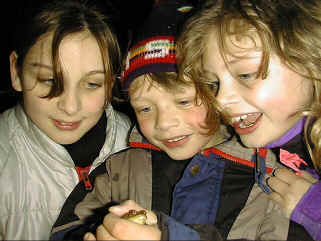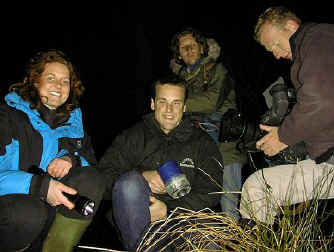Spawning - Toad Watch - Breeding Sites - Tadpoles - Lifespan- AVis - Sound
Breeding
 For most of the year, Common Toads tend to be solitary, living under logs and
stones, often well away from the water. They hibernate here usually from about mid-October
to mid-March. The timing will depend on weather conditions. When spring arrives, the toads
emerge from hibernation and migrate to breeding ponds, often in huge numbers. The toads
are very vulnerable at this point and many of them get run over on roads, which have to be
crossed to reach breeding grounds. In some areas, local residents organise 'Toad Patrols'
on nights when many toads are migrating, to help prevent too many deaths from speeding
cars. Road signs are sometimes also put up to warn motorists to slow down and attempt to
avoid the toads. However, it should be remembered that toads produce vast numbers of young
and providing there are suitable habitats for spawning and adult survival the population
can withstand significant losses.
For most of the year, Common Toads tend to be solitary, living under logs and
stones, often well away from the water. They hibernate here usually from about mid-October
to mid-March. The timing will depend on weather conditions. When spring arrives, the toads
emerge from hibernation and migrate to breeding ponds, often in huge numbers. The toads
are very vulnerable at this point and many of them get run over on roads, which have to be
crossed to reach breeding grounds. In some areas, local residents organise 'Toad Patrols'
on nights when many toads are migrating, to help prevent too many deaths from speeding
cars. Road signs are sometimes also put up to warn motorists to slow down and attempt to
avoid the toads. However, it should be remembered that toads produce vast numbers of young
and providing there are suitable habitats for spawning and adult survival the population
can withstand significant losses.
Breeding is triggered by environmental cues such as temperature
change and rainfall. At The Woodland
Education Centre, in Offwell, in a good year, several thousand toads will suddenly
appear as if from nowhere and then just as quickly disappear again once spawning is
completed. Ideal conditions occur on warm moist nights in late February through to the
middle of March depending on the weather.

Every year interested groups visit The Centre to take part in 'Toad Watch'. Small groups may come on one of several nights to see
for themselves the spectacular spawning of the toads. Often the night air is filled with
the sounds of the male toads augmented by the hooting of owls and the barking of foxes.
Anyone can come on a Toad Watch just contact the Trust.
Spawning
Males mature at 3 years, a year earlier than females, so there are
often many more males than available females at breeding sites. The males are smaller than
the females and usually arrive earlier. They may often be seen sitting bolt upright on
paths near to the pond, in an attempt to secure a passing female before other males arrive
on the scene. Successful males cling to the back of the female and hitch a ride to the pond AVI. Once in the pond,
unattached males face intense competition with other males for access to females.
Successful males cling to the back of the female and fertilise the eggs (spawn) as it is
laid. Sometimes many males will try to mate with a single female. This is known as a
mating ballAVI. Most of the spawning activity takes
place at night and the sound of their croaking
fills the night air.
 Toad spawning at The Woodland Education Centre has featured on television on
several occasions.
Toad spawning at The Woodland Education Centre has featured on television on
several occasions.
There are very few major amphibian breeding sites left now, so
places with ponds and wetland habitats such as The Centre are very important for the
toad's continued existence. Toad spawning at The Centre has recently been filmed for the
BBC2 programme 'The Animal Zone', broadcast on Sunday 28th March 1999.
Pictured above are presenters Bobbie Fletcher and Nick Baker; soundman Sean Millar
and cameraman Scott Tibbles.
Breeding sites
Toads seek fairly deep, well-oxygenated water preferably about 600mm deep to lay their
eggs. Frogs choose shallower water and can even breed in puddles and ditches where the
oxygen content of the water is much lower. Toad eggs are laid in long strands of
jelly that wrap around water plants. Common Toads lay strings with a double row of eggs
encased in the jelly, while Natterjack Toads lay strands with a single row of eggs.
Strings of spawn from Common Toads can measure 2-3m in length and may contain thousands of
eggs. Strings of Natterjack Toad spawn are 1-2m long. Enormous numbers of eggs are laid
because life is very perilous for the hatching tadpoles. They form food for many other
different kinds of animals (including fish, predatory beetles and dragonfly larvae and Kingfishers) and suffer heavy predation. Very few of the
tadpoles will actually survive to adult-hood.
Tadpoles
The hatching black tadpoles look very different to the adults. They breathe through
gills rather than lungs and have a tail for swimming, instead of legs. Initially the
tadpoles are herbivorous and have a small rasping mouth for scraping algae off surfaces in
the pond. The tadpoles gradually develop the mouthparts and legs of the adult. At this
stage they become carnivorous and finally lose the tail, emerging as toadlets. This
process usually takes 10 - 16 weeks, depending on weather conditions.
 The
minute young toads leave the water in June or July to shelter in the damp pond margins. On
rare occasions tadpoles do not develop into toads but remain in the juvenile state. This
is thought to be caused by environmental factors such as low water temperature.
The
minute young toads leave the water in June or July to shelter in the damp pond margins. On
rare occasions tadpoles do not develop into toads but remain in the juvenile state. This
is thought to be caused by environmental factors such as low water temperature.
The poison glands on the back of the toads offer some protection against predators.
When threatened, the toads adopt a head-down posture, thrusting the poison glands towards
the attacker. These glands secrete a weak poison which may deter some predators. The
poison tastes bad and may irritate the mouth of any predators attempting to eat them.
However, Grass Snakes will eat toads and some birds (e.g Buzzards) have learnt to eat the
toads while leaving the skin untouched.
Lifespan
The life span of Common Toads in captivity may be as high as 20-40 years, but in the
wild, it is more likely to be 10 - 12 years.
Ponds and lakes are vital to the continued existence of toads. In just 50 years 75% of
British ponds have disappeared. This drastic decline in wetland habitats places intense
pressure on those that remain. Garden ponds may offer some alternative but too often the
conditions are not suitable for toad spawning and tadpole survival. In any event they
cannot begin to replace the traditional wetland habitats being lost at such an alarming
rate.
Amphibians spend most of their adult lives out of water and it is therefore crucial
that there are transitional areas between water and dry land to enable them to survive.
These transitional areas provide the habitat in which the the newly emerged and older
adults can survive.
As with most species in Britain the loss of habitat is the single most important cause
of population decline. It is impossible to over emphasise the importance of the
restoration and preservation of existing habitats. An extensive amount of
wetland restoration work has been carried out at the Woodland Education Centre since 1986.
As a result the Centre is not only a major breeding site for amphibians but also other
endangered species such as Dragonflies. The restoration work has been funded by South West
Water Plc, BT and the Department of the Environment, Transport and Regions.
 For most of the year, Common Toads tend to be solitary, living under logs and
stones, often well away from the water. They hibernate here usually from about mid-October
to mid-March. The timing will depend on weather conditions. When spring arrives, the toads
emerge from hibernation and migrate to breeding ponds, often in huge numbers. The toads
are very vulnerable at this point and many of them get run over on roads, which have to be
crossed to reach breeding grounds. In some areas, local residents organise 'Toad Patrols'
on nights when many toads are migrating, to help prevent too many deaths from speeding
cars. Road signs are sometimes also put up to warn motorists to slow down and attempt to
avoid the toads. However, it should be remembered that toads produce vast numbers of young
and providing there are suitable habitats for spawning and adult survival the population
can withstand significant losses.
For most of the year, Common Toads tend to be solitary, living under logs and
stones, often well away from the water. They hibernate here usually from about mid-October
to mid-March. The timing will depend on weather conditions. When spring arrives, the toads
emerge from hibernation and migrate to breeding ponds, often in huge numbers. The toads
are very vulnerable at this point and many of them get run over on roads, which have to be
crossed to reach breeding grounds. In some areas, local residents organise 'Toad Patrols'
on nights when many toads are migrating, to help prevent too many deaths from speeding
cars. Road signs are sometimes also put up to warn motorists to slow down and attempt to
avoid the toads. However, it should be remembered that toads produce vast numbers of young
and providing there are suitable habitats for spawning and adult survival the population
can withstand significant losses.
 Toad spawning at The Woodland Education Centre has featured on television on
several occasions.
Toad spawning at The Woodland Education Centre has featured on television on
several occasions.  The
minute young toads leave the water in June or July to shelter in the damp pond margins. On
rare occasions tadpoles do not develop into toads but remain in the juvenile state. This
is thought to be caused by environmental factors such as low water temperature.
The
minute young toads leave the water in June or July to shelter in the damp pond margins. On
rare occasions tadpoles do not develop into toads but remain in the juvenile state. This
is thought to be caused by environmental factors such as low water temperature.